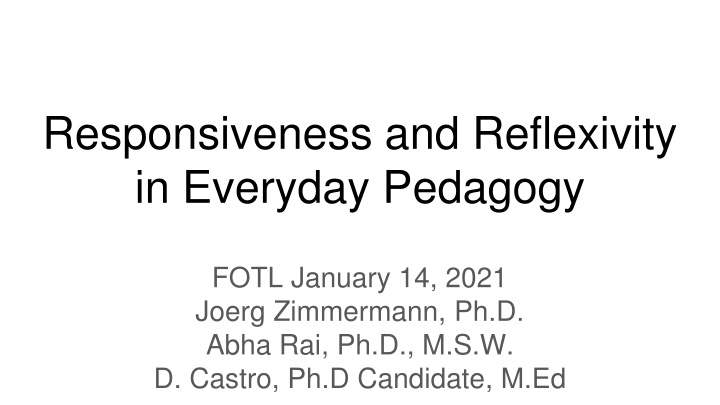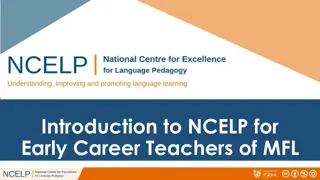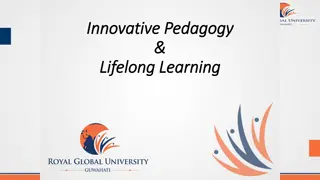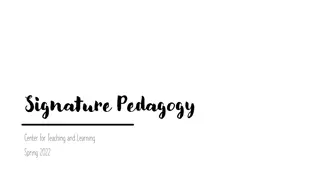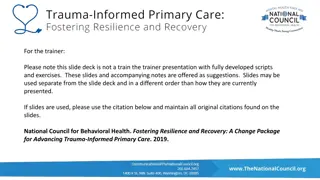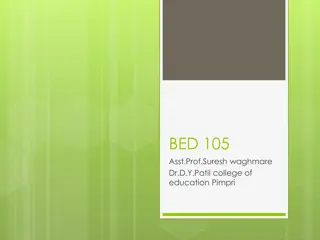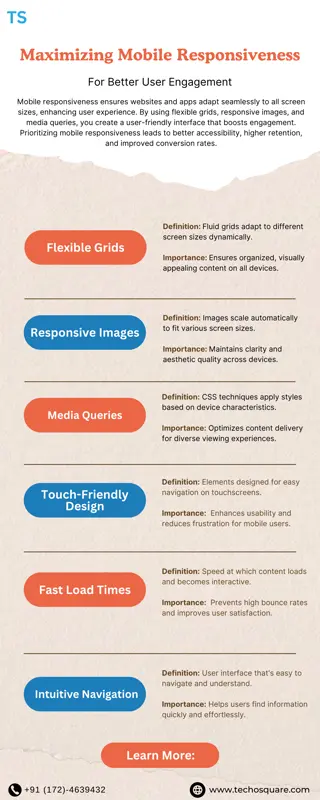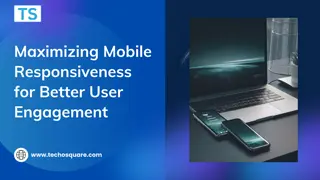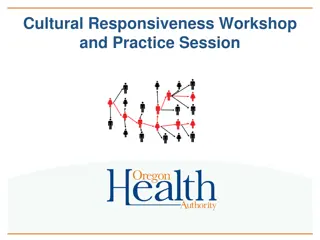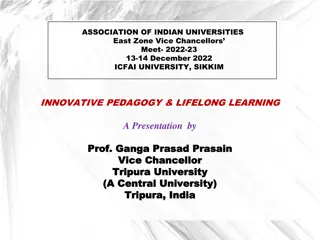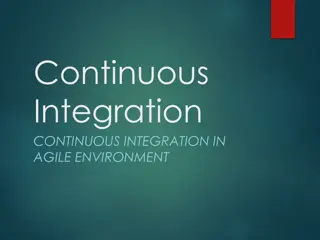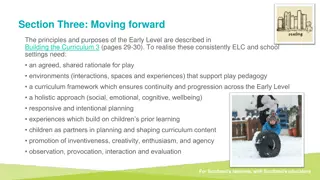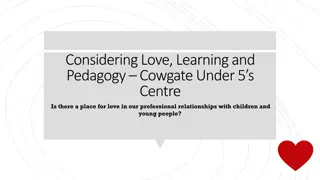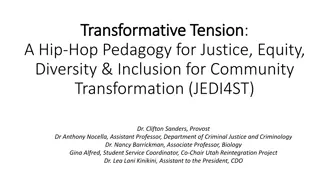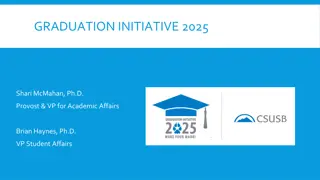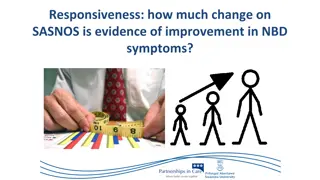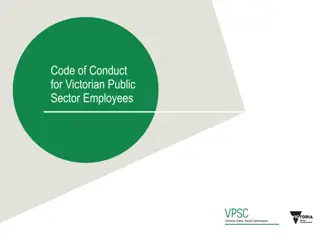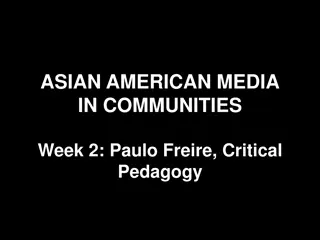Responsiveness and Reflexivity in Everyday Pedagogy
This content delves into creating responsive and reflexive classroom cultures, fostering personal relationships, and implementing feminist teaching pedagogy. It emphasizes flexibility in facilitation and encourages continued student engagement through diverse assignments and formative assessments.
Uploaded on Feb 28, 2025 | 0 Views
Download Presentation

Please find below an Image/Link to download the presentation.
The content on the website is provided AS IS for your information and personal use only. It may not be sold, licensed, or shared on other websites without obtaining consent from the author.If you encounter any issues during the download, it is possible that the publisher has removed the file from their server.
You are allowed to download the files provided on this website for personal or commercial use, subject to the condition that they are used lawfully. All files are the property of their respective owners.
The content on the website is provided AS IS for your information and personal use only. It may not be sold, licensed, or shared on other websites without obtaining consent from the author.
E N D
Presentation Transcript
Responsiveness and Reflexivity in Everyday Pedagogy FOTL January 14, 2021 Joerg Zimmermann, Ph.D. Abha Rai, Ph.D., M.S.W. D. Castro, Ph.D Candidate, M.Ed
sites.northwestern.edu/msaatnu/2020/07/09/the-i-in-identity-series-identity-wheel-self-reflection/sites.northwestern.edu/msaatnu/2020/07/09/the-i-in-identity-series-identity-wheel-self-reflection/
Creating Classroom Cultures with Castro
Looking in & building out Before creating and establishing classroom norms reflect: - What kinds of things to I need in the learning environment to be an educator and learner? - What am I willing to do to for my students to build an environment that sees them as developing scholars and members of a community?
Looking in & building out Build opportunities for personal relationships to develop - - - - - - Allow students to opt out of ice breakers Hold 1-to-1 relational meetings Music Personality surveys Think-Pair-Share Embrace the tension that comes from decentralizing our power-over
Flexibility in facilitation Evaluate class format often - - Anonymously Implement feedback as soon as possible
Feminist Teaching Pedagogy with Abha Minimizing power imbalance in the classroom and devaluing hierarchy Classroom as a shared and safe space Everyone is a teacher and a student in the classroom!
Classroom community Classroom style & Syllabus Continued engagement outside the classroom By the students, For the students and Of the students Assignments Formative assessment In-class discussions
Classroom community Classroom style & Syllabus Beginning the semester by reflecting on our own positionalities and impact on implicit bias Assignments Students could submit a diverse range of assignments podcasts, papers, Twitter/Instagram posts etc. Setting class norms at the beginning Suggest new content for the class through asynchronous discussions Beginning class with one-word check-in s to set the tone of the class Student self-assessment of class performance Adding voices of color to the syllabus to diversify the syllabus
Classroom community In-class Discussions Formative Assessment Begin in-class discussions with ice-breakers to engage all students Student questionnaire at the beginning Ongoing student assessments about the content and teaching style In-class journaling and prompts
Cultural Validation College students, especially from non-traditional backgrounds, need progressive and sustained assistance to ensure they stay enrolled and graduate from college L. Rendon (2002) Community College Puente: A Validating Model of Education. Educational Policy, 16, 4, 642-667
Traditional Students Non-Traditional Students white, middle- or upper-class students, not first in their family to attend college low income, working class, first in their family to attend college, students of color coming to the university with social and cultural capital may have doubts about their ability to do well in college have been exposed to, or even pressured to consider more realistic educational and occupational choices college is an expected rite of passage attended well sourced high schools and well educated teachers attended low resourced high schools people in their lives see them as smart and on their way to being the next generation of leaders parents, while possibly emotionally supportive, may not be able to help students navigate the university or take full advantage of college
Validation in Praxis institutional agents, not students, are expected to take the first step to not only promote involvement but to affirm students as knowers and valuable members of the college community L. Rendon (2002) Community College Puente: A Validating Model of Education. Educational Policy, 16, 4, 642-667
Validation in Praxis encourage: provide positive feedback, stress academic strength individualize interactions and feedback and keep notes actively connect students to campus services affirm the value of student voice and experience use instant polling instead of calling on students (Sakai, TopHat, Poll Everywhere, iClicker) schedule communication e.g. by students submitting unanswered questions at the end of each class or a free-write activity at the beginning of class
Activities to Address and Recognize Student Identity This could be me students search for and create profiles of faculty that share one or more aspects of their identity Potato and Patata - students share scientific terms in their native languages I AM FROM students reflect on their identity by completing a poem template Digital Testimonio students record videos about their out-of-school life
Inspired by Where Im From by George Ella Lyon Marissa Vasquez, Asst. Professor, Cal State San Marcos
When validation is present, students feel capable of learning and have a sense of self worth Students will think: I matter. Somebody cares about me. I am a capable person.
